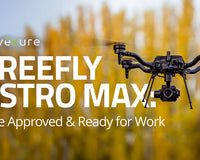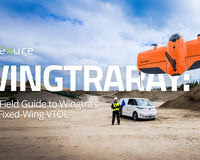Imagine being tasked with monitoring thousands of acres of dense forest—tracking wildlife, assessing tree health, and spotting signs of fire risk—all while ensuring your team’s safety in difficult terrain. How can one possibly cover that much ground efficiently?
In recent years, drones have revolutionized forest management by providing powerful aerial solutions that streamline operations, reduce risk, and offer real-time data. In an era where forests are under increasing pressure from climate change, wildfires, and illegal activities, forest professionals need innovative tools to stay ahead.
This blog will explore the key challenges forestry managers face and how UAS is helping them make data-driven decisions.
Overcoming Modern Challenges in Forestry
Managing forests is more complex than ever, with professionals facing a range of challenges that demand innovative solutions. Here are some of the most pressing issues forest managers face today:

Monitoring Vast Areas
Forests cover 31% of the Earth’s land surface, equivalent to about 4.06 billion hectares. Monitoring these vast areas is a monumental task, particularly when traditional methods like ground surveys are time-consuming and labor-intensive. In large-scale operations, delays in identifying threats like pest infestations or illegal activities can lead to irreversible damage.
Wildfire Detection and Prevention
Climate change has dramatically increased the frequency and intensity of wildfires. In 2021 alone, wildfires consumed over 7.1 million acres of U.S. forests . Detecting fires early is critical to preventing their spread, but traditional surveillance methods often fall short, particularly in remote or inaccessible areas. Delayed responses can turn small blazes into catastrophic events, threatening ecosystems, wildlife, and human communities.
Illegal Logging and Poaching
In some countries, Illegal logging is responsible for up to 90% of deforestation in tropical forests, significantly contributing to biodiversity loss and climate change. Remote forest areas are especially vulnerable, as forest rangers cannot cover enough ground to detect these activities quickly. Similarly, poaching remains a persistent threat to endangered species, further destabilizing forest ecosystems.
Tree Health and Disease Monitoring
Forests are frequently plagued by pests and diseases, which can devastate entire ecosystems if not detected early. In North America, the emerald ash borer, an invasive species of beetle from Asia, has killed hundreds of millions of ash trees . Detecting tree diseases manually is both time-consuming and expensive, often requiring extensive ground-level surveys, which may miss early signs of disease or pest infestationsAssessing Forest Recovery and Sustainability
Whether from wildfires, logging, or natural disasters, forests need time to recover. Monitoring their recovery process is crucial to ensuring sustainable forest management. However, keeping track of forest regeneration is complicated by the size of the areas in question and the lack of precise data. Traditional methods often fall short in providing timely and accurate insights, hindering efforts to sustain healthy ecosystems.
Aerial Insights to High-Impact Solutions
From monitoring vast areas to detecting wildfires, drones offer capabilities that traditional methods can't match. Here’s a closer look at how drones help address key forestry challenges:

Aerial Surveillance and Mapping
Instead of relying on manual ground surveys or the high costs of helicopters, drones can perform comprehensive aerial assessments of forested areas quickly. Equipped with high-resolution cameras, drones like the DJI Mavic 3 Enterprise allow forest managers to capture real-time data, create detailed maps, and monitor forest health over time without disrupting the ecosystem.

Fire Detection with Thermal Imaging
With wildfires on the rise, early detection is critical. Drones equipped with thermal cameras can detect heat anomalies and track fire-prone areas, providing an invaluable tool for rapid response. Thermal drones enable forest managers to monitor large areas for signs of fire before they spread, reducing damage to forests and wildlife.
Wildlife and Poaching Surveillance
Monitoring wildlife and preventing illegal activities, such as poaching and illegal logging, are critical to preserving biodiversity. Drones offer a low-impact, non-intrusive way to conduct surveillance over large and remote forest areas. Equipped with high-resolution cameras and GPS capabilities, drones can provide accurate data on animal movements, enabling forest managers to protect wildlife while monitoring areas for unauthorized activities.
The Impact of LiDAR on Forestry Work

LiDAR (Light Detection and Ranging) technology has become a game-changer for forestry professionals, offering precision and depth in data collection that traditional methods, and even some drone-based imaging techniques, cannot match.
Enhanced Terrain Mapping
Forests often cover rugged, uneven terrain that can be difficult to map accurately using conventional methods. LiDAR-sensors, like the DJI Zenmuse L2, can penetrate dense vegetation to create precise 3D models of the forest floor. By sending out pulses of laser light and measuring their return times, LiDAR provides highly accurate elevation data even through thick tree canopies . This makes it invaluable for assessing terrain features such as slopes, ridges, and valleys.
Detailed Vegetation Structure Assessment
LiDAR offers a unique ability to capture the vertical structure of forests, making it possible to measure tree height, canopy density, and the under-story vegetation that other methods might miss. This level of detail is essential for creating accurate forest inventories, monitoring biodiversity, and evaluating forest health.
Carbon Sequestration and Biomass Estimation
As concerns about climate change grow, measuring and managing carbon sequestration in forests has become a top priority. LiDAR's ability to accurately assess tree volume and canopy cover enables forest managers to estimate the amount of carbon being stored in trees . This data is crucial for monitoring how forests contribute to mitigating climate change and for developing sustainable management practices that maximize carbon capture.
Post-Disaster Assessment
LiDAR's ability to collect data from beneath the forest canopy makes it an excellent tool for assessing damage after natural disasters, such as wildfires, hurricanes, or floods. LiDAR can generate detailed digital terrain models (DTMs) and digital surface models (DSMs) to assess how terrain and vegetation have been impacted, providing forest professionals with crucial data for recovery planning and reforestation efforts.
Advexure's Top Drone Picks for Forest Management
-
DJI Matrice 350 RTK with Zenmuse L2 LiDAR – For LiDAR Applications
Perfect for precise terrain mapping and vegetation analysis. LiDAR penetrates dense canopies, capturing ground data in challenging environments, making it ideal for forest surveys and post-disaster assessments.
Key Specs:
- Flight Time: 55 min
- Detection Range: 250 m @10% reflectivity
- LiDAR Point Rate: 240,000 pts/sec
- Accuracy: 4 cm vertical, 5 cm horizontal
- IP Rating: IP55
-
DJI Matrice 350 RTK with Zenmuse P1 – For Photogrammetry
Best for large-scale, high-precision mapping. The 45 MP full-frame sensor captures detailed orthomosaics and 3D models.
Key Specs:
- Flight Time: 55 min
- Camera: 45 MP full-frame
- IP Rating: IP55
-
Mapping Accuracy: 3 cm horizontal, 5 cm vertical
-
Autel EVO Max 4N – For Night Vision
Excellent for low-light operations such as wildlife monitoring and night-time surveillance. Its night vision capabilities offer clear visuals even in near-total darkness.
Key Specs:
- Flight Time: 42 min
- Special Feature: Enhanced low-light camera
-
DJI Mavic 3 Multispectral – For Vegetation Health Monitoring
Designed for capturing multispectral data to assess vegetation health, this compact drone excels at early disease detection and efficient forest management.
Key Specs:
- Flight Time: 45 min
- Camera: 4-band multispectral sensor
-
DJI Matrice 30T – For Fire Detection and Thermal Imaging
The DJI Matrice 30T is perfect for detecting forest fires and monitoring wildlife, featuring a thermal camera, 48 MP zoom, and a laser rangefinder that pinpoints objects up to 1,200 meters away. Its rugged design, IP55 rating, and ability to operate in extreme conditions make it ideal for forest management in harsh environments.
Key Specs:
- Flight Time: 41 min
- Thermal Camera Resolution: 640×512 px
- Zoom: 48 MP, 16x optical zoom, 200x digital zoom
- Laser Rangefinder: 1,200 m range
- IP Rating: IP55
- Flight Time: 41 min
-
DJI Mavic 3 Enterprise – For Mapping and Surveying
Lightweight yet powerful, this drone provides high-resolution mapping for routine forest assessments. Ideal for mapping large areas with precision.
Key Specs:
- Flight Time: 45 min
- Camera: 20 MP, 4/3-inch CMOS
- Coverage: 16 km² per day
Transform Your Forestry Work with UAS
UAS is reshaping the way forests are managed, providing precision, efficiency, and data-rich insights that traditional methods can’t match. Whether you're looking to improve fire detection, monitor forest health, or enhance wildland mapping, Advexure has the right drone solution for your needs.
Reach out to Advexure today for a customized quote. Our team of experts will guide you through the best options tailored to your specific requirements.










